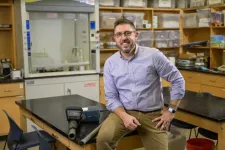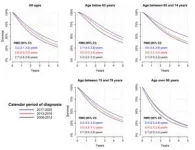(Press-News.org) DALLAS (SMU) – It’s long been understood that human settlement contributes to conditions that make Pacific Islands more susceptible to wildfires, such as the devastating Aug. 8 event that destroyed the Maui community of Lahaina. But a new study from SMU fire scientist Christopher Roos published in the journal Nature Ecology and Evolution shows that climate is an undervalued part of the equation.
Roos, SMU environmental archaeologist and professor of anthropology, traveled with his team to the Sigatoka River valley in southwestern Fiji in 2013, where they collected charcoal and stable carbon isotopes from deep soil cores to understand historic patterns of fire activity in the area. Different plants have distinct carbon isotopic signatures, which can provide information about past plant communities.
The team found fires and fire-created grassy areas that predate human settlement by millennia and actively corresponded to droughts likely driven by a regularly occurring weather pattern known as El Niño. El Niño events can alter precipitation patterns worldwide, making environmental conditions more favorable for wildfires. The National Oceanic and Atmospheric Administration issued an El Niño advisory in June, announcing the latest arrival of the climate event that continues to influence weather worldwide.
Lighting strikes also act as a natural cause of wildfires, igniting plant material that acts as fuel.
The impact of human settlement, farming activity (particularly the clearing and burning of land) and resulting deforestation of remote Pacific islands is well established in the scientific record, and research from the Roos team only confirms what Roos calls “a modern environmental parable.” But the impact of climate must be considered, too, the study finds.
“It struck me that these fires are not exclusively human-driven, because when I looked at earlier pre-human spikes in fire activity, those lined up with El Niños,” said Roos. “The combination of climate and human activity drives island deforestation and increases wildfire activity. It may be that human activity is making the landscape more sensitive to those climate variations. But, it could also be that the climate is making the landscape more sensitive to human activity.”
In the past, Roos said, research often focused more on human activity harming Pacific Islands' land without considering climate's role in the damage. He believes an approach that considers both causes is necessary, especially with catastrophic wildfire events occurring more regularly.
Roos also points out that the Pacific Islands are natural laboratories to study the grass-fire cycle, which is prevalent in areas where wildfire is occurring with the spread of invasive grasses. Traditional farmers have practiced successful techniques for clearing and burning land for centuries, and past lessons could offer ways to prepare and cope with future wildfire events. Roos stresses that we must adapt to the new environment climate and humans have created.
“Droughts triggered by El Niño events appear to have played a role in intensifying the grass-fire cycle and contributing to deforestation in the past," he said. "And looking forward, climate models indicate that the Pacific Islands could experience conditions similar to El Niño events more frequently due to ongoing climate change. We need to reflect on what we’re doing and whether or not those actions make places more or less vulnerable to future wildfire events.”
Research team members included Julie S. Field, from Ohio State University and John V. Dudgeon, Idaho State University and the Center for Archaeology, Materials, and Applied Spectroscopy at Idaho State University.
About SMU
SMU is the nationally ranked global research university in the dynamic city of Dallas. SMU’s alumni, faculty and more than 12,000 students in eight degree-granting schools demonstrate an entrepreneurial spirit as they lead change in their professions, communities and the world.
END
Climate and human land use both play roles in Pacific island wildfires past and present
Research from SMU fire anthropologist shows Fiji grassland fires predate human settlement by thousands of years. Study calls for greater consideration of climate as a factor contributing to fires
2023-10-02
ELSE PRESS RELEASES FROM THIS DATE:
DeepMB: a deep learning framework for high-quality optoacoustic imaging in real-time
2023-10-02
Researchers at Helmholtz Munich and the Technical University of Munich have made significant progress in advancing high-resolution optoacoustic imaging for clinical use. Their innovative deep-learning framework, known as DeepMB, holds great promise for patients dealing with a range of illnesses, including breast cancer, Duchenne muscular dystrophy, and inflammatory bowel disease. Their findings have been now published in Nature Machine Intelligence.
In order to understand and detect diseases scientists and medical staff often rely on imaging methods such as ultrasound or X-ray. However, ...
Overlooked parts of proteins revealed as critical to fundamental functions of life
2023-10-02
According to textbooks, proteins work by folding into stable 3D shapes that, like Lego blocks, precisely fit with other biomolecules.
Yet this picture of proteins, the "workhorses of biology," is incomplete. Around half of all proteins have stringy, unstructured bits hanging off them, dubbed intrinsically disordered regions, or IDRs. Because IDRs have more dynamic, “shape-shifting” geometries, biologists have generally thought that they cannot have as precise of a fit with other biomolecules as their folded ...
Not the usual suspects: New interactive lineup boosts eyewitness accuracy
2023-10-02
Allowing eyewitnesses to dynamically explore digital faces using a new interactive procedure can significantly improve identification accuracy compared to the video lineup and photo array procedures used by police worldwide, a new study reveals.
Interactive lineups present digital 3D faces that witnesses can rotate and view from different angles using a computer mouse - enabling witnesses to actively explore and match faces to their recollection.
Publishing their findings today (2 Oct) in Proceedings of the National Academy of Sciences, psychologists found that the interactive procedure enhanced people’s ability to correctly identify perpetrators and avoid misidentifications.
Lead ...
Yang developing training dataset labeling tool
2023-10-02
Chaowei Yang, Professor, Director, NSF Spatiotemporal Innovation Center, Geography and Geoinformation Science, received funding from the National Science Foundation for the project: "I-Corps: An automatic training dataset labeling tool for producing large amount of quality training datasets."
He and his collaborators are interviewing more than 100 potential customers to: a) identify a customer sector that has the potential to show early success, b) define from a customer perspective a Minimum Viable Product (MVP), c) explore the potential and plan to create a startup by a team composed of ...
Loneliness and risk of Parkinson disease
2023-10-02
About The Study: This study of 491,000 participants followed up for up to 15 years found that loneliness was associated with risk of incident Parkinson disease across demographic groups and independent of depression and other prominent risk factors and genetic risk. The findings add to the evidence that loneliness is a substantial psychosocial determinant of health.
Authors: Antonio Terracciano, Ph.D., of the Florida State University College of Medicine in Tallahassee, is the corresponding author.
To access the embargoed study: Visit our For The Media website at this link https://media.jamanetwork.com/
(doi:10.1001/jamaneurol.2023.3382)
Editor’s ...
Paxlovid and COVID-19 mortality and hospitalization among patients with vulnerability to COVID-19 complications
2023-10-02
About The Study: In this study of 6,866 individuals with COVID-19, nirmatrelvir and ritonavir (Paxlovid [Pfizer]) treatment was associated with reduced risk of COVID-19 hospitalization or death in clinically extremely vulnerable individuals, with the greatest benefit observed in severely immunocompromised individuals. No reduction in the primary outcome (death from any cause or emergency hospitalization with COVID-19 within 28 days) was observed in lower-risk individuals, including those age 70 or older without serious comorbidities.
Authors: Colin R. Dormuth, Sc.D., ...
Discrimination alters brain-gut ‘crosstalk,’ prompting poor food choices and increased health risks
2023-10-02
People frequently exposed to racial or ethnic discrimination may be more susceptible to obesity and related health risks in part because of a stress response that changes biological processes and how we process food cues. These are findings from UCLA researchers conducting what is believed to be the first study directly examining effects of discrimination on responses to different types of food as influenced by the brain-gut-microbiome (BGM) system.
The changes appear to increase activation in regions of the brain associated with reward and self-indulgence – like seeking “feel-good” ...
Tablet-based AI app measures multiple behavioral indicators to screen for autism
2023-10-02
DURHAM, N.C. – Researchers at Duke University have demonstrated an app driven by AI that can run on a tablet to accurately screen for autism in children by measuring and weighing a variety of distinct behavioral indicators.
Called SenseToKnow, the app delivers scores that evaluate the quality of the data analyzed, the confidence of its results and the probability that the child tested is on the autism spectrum. The results are fully interpretable, meaning that they spell out exactly which of the behavioral indicators led to its conclusions and why.
This ability ...
Advanced bladder cancer patients could keep their bladder under new treatment regime, clinical trial shows
2023-10-02
New York, NY (October 2, 2023)—Mount Sinai investigators have developed a new approach for treating invasive bladder cancer without the need for surgical removal of the bladder, according to a study published in Nature Medicine in September. Removing the bladder is currently a standard approach when cancer has invaded the muscle layer of the bladder.
In a phase 2 clinical trial that was the first of its kind, doctors found that some patients could be treated with a combination of chemotherapy and immunotherapy without the need to remove their bladder. ...
Plant chloroplasts promise potential therapy for Huntington’s disease
2023-10-02
Researchers at the University of Cologne’s CECAD Cluster of Excellence for Aging Research and the CEPLAS Cluster of Excellence for Plant Sciences have found a promising synthetic plant biology approach for the development of a therapy to treat human neurodegenerative diseases, especially Huntington’s disease. In their publication “In-planta expression of human polyQ-expanded huntingtin fragment reveals mechanisms to prevent disease-related protein aggregation” in Nature Aging, they showed that a synthetic enzyme derived from plants – stromal processing peptidase (SPP) – reduces the clumping of proteins responsible for the pathological changes ...
LAST 30 PRESS RELEASES:
Making lighter work of calculating fluid and heat flow
Normalizing blood sugar can halve heart attack risk
Lowering blood sugar cuts heart attack risk in people with prediabetes
Study links genetic variants to risk of blinding eye disease in premature infants
Non-opioid ‘pain sponge’ therapy halts cartilage degeneration and relieves chronic pain
AI can pick up cultural values by mimicking how kids learn
China’s ecological redlines offer fast track to 30 x 30 global conservation goal
Invisible indoor threats: emerging household contaminants and their growing risks to human health
Adding antibody treatment to chemo boosts outcomes for children with rare cancer
Germline pathogenic variants among women without a history of breast cancer
Tanning beds triple melanoma risk, potentially causing broad DNA damage
Unique bond identified as key to viral infection speed
Indoor tanning makes youthful skin much older on a genetic level
Mouse model sheds new light on the causes and potential solutions to human GI problems linked to muscular dystrophy
The Journal of Nuclear Medicine ahead-of-print tip sheet: December 12, 2025
Smarter tools for peering into the microscopic world
Applications open for funding to conduct research in the Kinsey Institute archives
Global measure underestimates the severity of food insecurity
Child survivors of critical illness are missing out on timely follow up care
Risk-based vs annual breast cancer screening / the WISDOM randomized clinical trial
University of Toronto launches Electric Vehicle Innovation Ontario to accelerate advanced EV technologies and build Canada’s innovation advantage
Early relapse predicts poor outcomes in aggressive blood cancer
American College of Lifestyle Medicine applauds two CMS models aligned with lifestyle medicine practice and reimbursement
Clinical trial finds cannabis use not a barrier to quitting nicotine vaping
Supplemental nutrition assistance program policies and food insecurity
Switching immune cells to “night mode” could limit damage after a heart attack, study suggests
URI-based Global RIghts Project report spotlights continued troubling trends in worldwide inhumane treatment
Neutrophils are less aggressive at night, explaining why nighttime heart attacks cause less damage than daytime events
Menopausal hormone therapy may not pose breast cancer risk for women with BRCA mutations
Mobile health tool may improve quality of life for adolescent and young adult breast cancer survivors
[Press-News.org] Climate and human land use both play roles in Pacific island wildfires past and presentResearch from SMU fire anthropologist shows Fiji grassland fires predate human settlement by thousands of years. Study calls for greater consideration of climate as a factor contributing to fires




